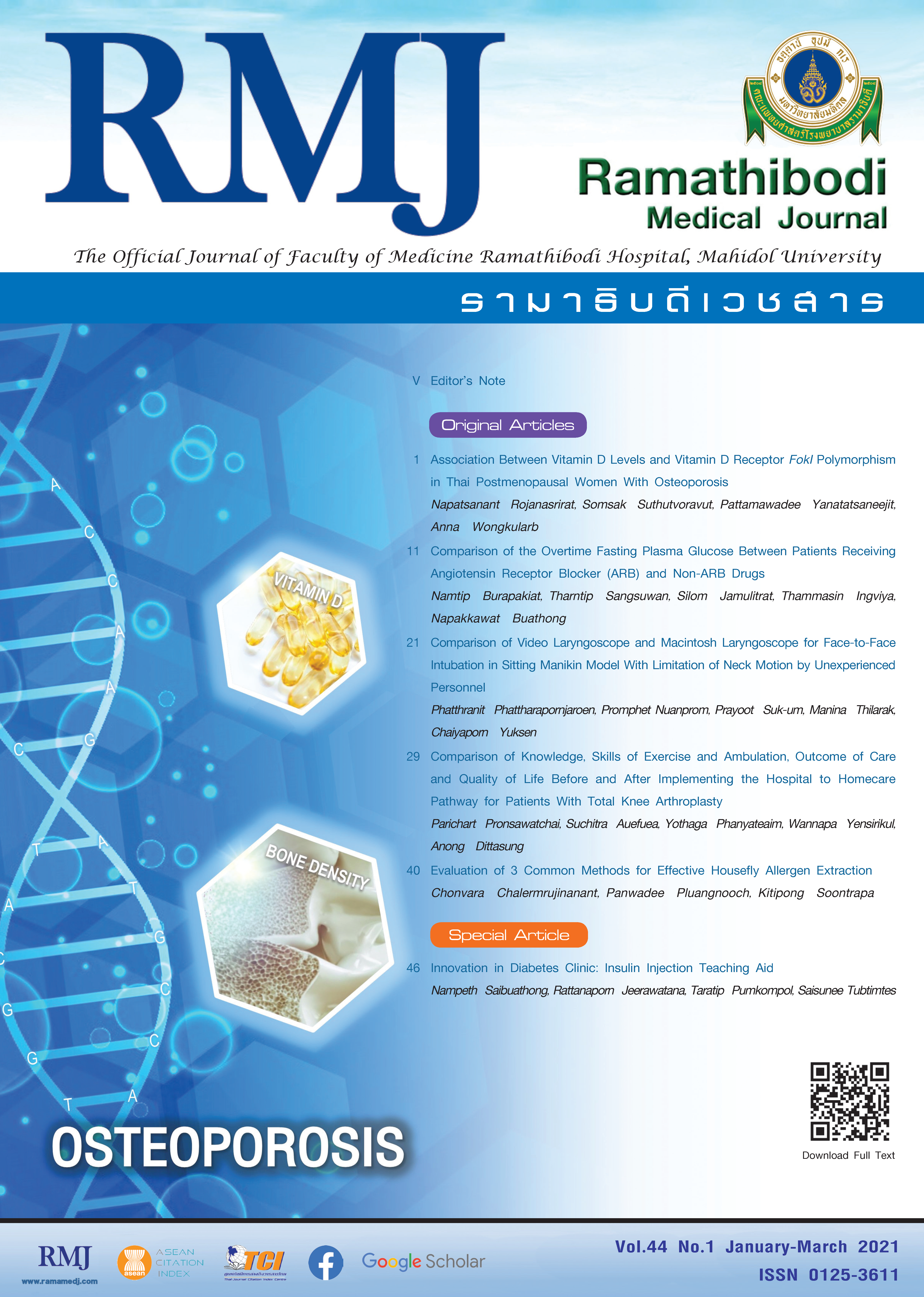Comparison of Knowledge, Skills of Exercise and Ambulation, Outcome of Care and Quality of Life Before and After Implementing the Hospital to Homecare Pathway for Patients With Total Knee Arthroplasty
DOI:
https://doi.org/10.33165/rmj.2021.44.1.230145Keywords:
Quality of life, Homecare pathway, TKA, Total knee arthroplasty, Outcome of careAbstract
Background: The hospital to homecare pathway for patients with total knee arthroplasty was developed and needed to be evaluated for effectiveness and improvement.
Objective: To compare knowledge, skills of exercise and ambulation, outcomes of nursing care and quality of life before and after implementing the hospital to homecare pathway for patients with total knee arthroplasty (HHPTKA).
Methods: This quasi-experimental study was purposively selected 50 cases referred to the home health care unit, ambulatory care nursing service, Ramathibodi Hospital. The HHPTKA included providing and evaluating the knowledge, exercise and ambulation skill, and other outcomes at day 0 (before operation), day 3 (post operation), day 10 (home visit), and day 14 (outpatient follow-up). Data were collected by questionnaire and assessment tools which analyzed by descriptive statistics, paired t test, and analysis of variance (ANOVA).
Results: There were statistically significant differences before and after the implementation of HHPTKA (P < .001). Mean scores of knowledge, skills of exercise and ambulation, quality of life, and degree of range of motion of knee were higher than before, pain score was decreased, and knee extension was increased. Only 1 case faced with wound bleeding at day 14 post operation.
Conclusions: HHPTKA could direct standard practice for home care nurses.
References
Apichantramethakul K, Sroisong S, Eiu-Seeyok B. Nursing for clients with knee osteoarthritis undergoing knee replacement surgery. JPNC. 2018;29(1):233-238.
Nimit-arnun N. The epidemiological situation and risk assessment of knee osteoarthritisamong Thai people. JRTAN. 2014;15(3):185-194.
Royal College of Orthopaedic Surgeons of Thailand. Guideline for the Treatment of Osteoarthritis of Knee. Bangkok: Royal College of Orthopaedic Surgeons of Thailand; 2011:76. Accessed January 4, 2021. https://www.chiangmaihealth.go.th/cmpho_web/document/160610146554495425.pdf
Chawengkiattikul S, Aree-Ue S, Youngcharoen P, Kawinwonggowit V. Patients’ expectations to postoperative outcomes among older adults undergoing total knee arthroplasty and its related factors. JOPN. 2019;11(2):361-373.
Lehtonen EJ, Hess MC, McGwin G Jr, Shah A, Godoy-Santos AL, Naranje S. Risk factors for early hospital readmission following total knee arthroplasty. Acta Ortop Bras. 2018;26(5):309-313. doi:10.1590/1413-785220182605190790
Ramos NL, Karia RJ, Hutzler LH, Brandt AM, Slover JD, Bosco JA. The effect of discharge disposition on 30-day readmission rates after total joint arthroplasty. J Arthroplasty. 2014;29(4):674-677. doi:10.1016/j.arth.2013.09.010
Cohen J. Statistical Power Analysis of the Behavioral Sciences. 2nd ed. Hillsdale, NJ: L. Erlbaum Associates; 1988. Accessed January 4, 2021. http://www.utstat.toronto.edu/~brunner/oldclass/378f16/readings/CohenPower.pdf
Chaipinyo K. Knee injury and osteoarthritis outcome score; 2009. Accessed January 4, 2021. http://www.koos.nu/ThaiKOOS.pdf
Prasanatikom W, Subhadrabandhu T, Kittimanont H. Analysis of length of stay in Hospital, opportunity cost and quality of care in patients with total knee arthroplasty at the Faculty of Medicine Ramathibodi Hospital. JPR2R. 2015;2:16-24. doi:10.14456/jpr2r.2015.2
Nakpalad W, Khupantavee N, Sangchan H. The development and evaluation of clinical nursing practice guideline for promoting the recovery of older patients with total knee arthroplasty. JOPN. 2019;11(1):73-85.
Chan EY, Blyth FM, Nairn L, Fransen M. Acute postoperative pain following hospital discharge after total knee arthroplasty. Osteoarthr Cartil. 2013;21(9):1257-1263. doi:10.1016/j.joca.2013.06.011
Musumeci G, Mobasheri A, Trovato FM, Szychlinska MA, Imbesi R, Castrogiovanni P. Post-operative rehabilitation and nutrition in osteoarthritis. F1000Res. 2014;3:116. doi:10.12688/f1000research.4178.3
Painupong I, Sae-Sia W, Kupantawee N. Pain management programme and self-empowerment exercise activity: their impact on elderly total knee arthroplasty patients’ recovery. JTNMC. 2015;30(1):99-111.
Yooyen J, Wirojratana V, Jitramontree N, Pinyopasakul W. The effectiveness of caregivers preparedness program in caring for older patients undergoing knee arthroplasty on readiness and satisfaction of caregivers. J Nurs Sci. 2017;35(1):85-99.
da Silva RR, Santos AA, de Sampaio Carvalho Júnior J, Matos MA. Quality of life after total knee arthroplasty: systematic review. Rev Bras Ortop. 2014;49(5):520-527. doi:10.1016/j.rboe.2014.09.007
Bureau of Nutrition. HLworkingage. Department of Health, Ministry of Public Health; 2018. Accessed January 4, 2021. http://nutrition.anamai.moph.go.th/images/files/HLworkingage.pdf
Hormnaim N. The nursing roles to promote wound healing by using nutrition principles. JOPN. 2014;6(2):234-249.

















